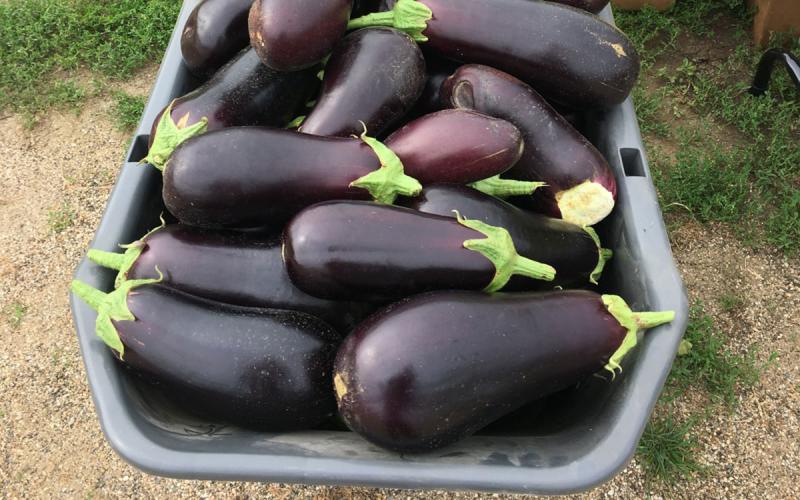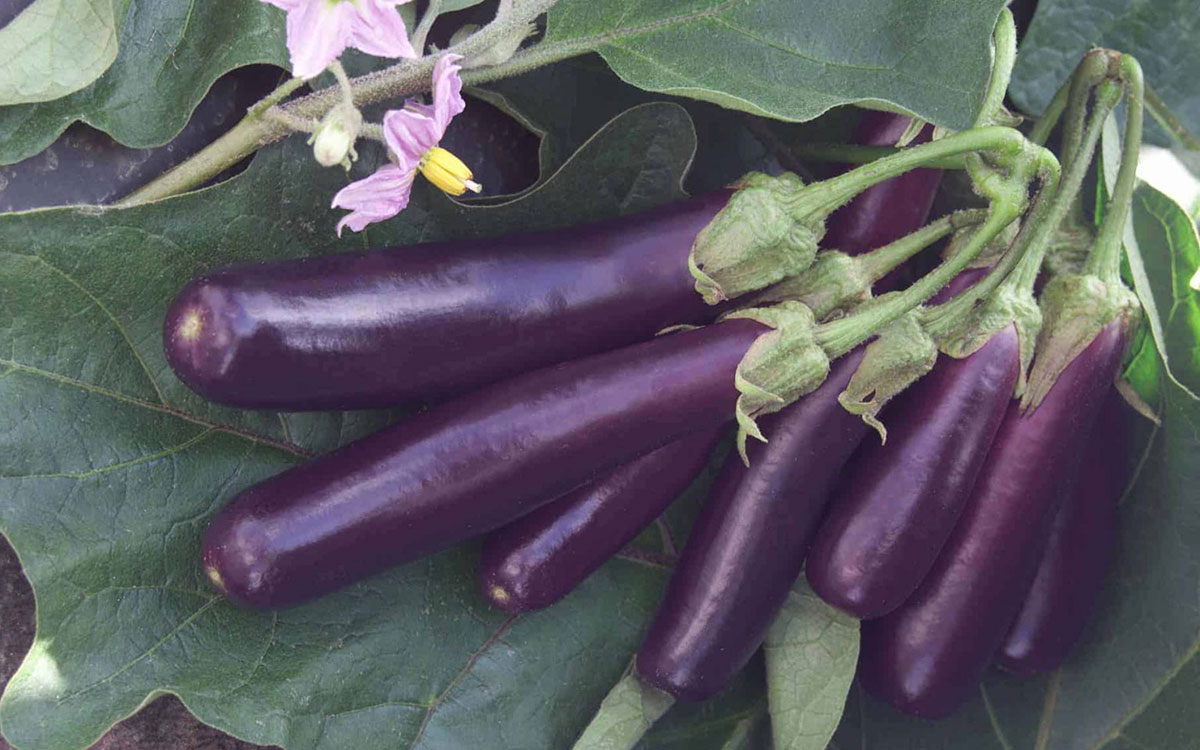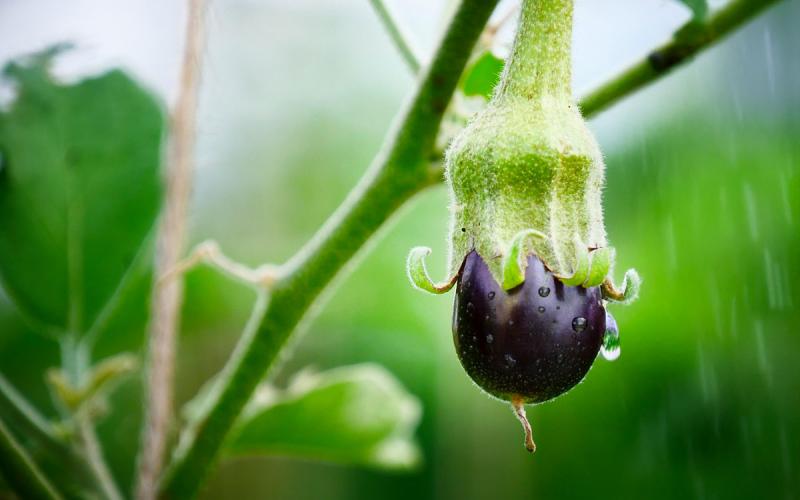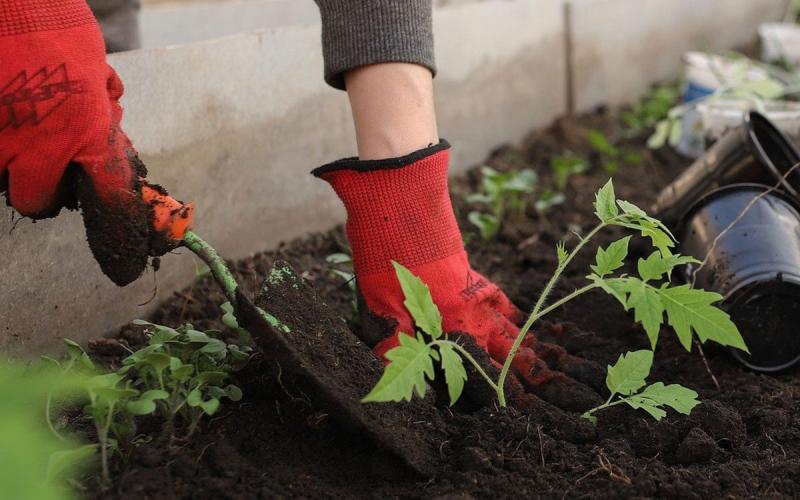Written by Prairey Walkling and Vaughn Reints under the direction and review of Rhoda Burrows, former Professor & SDSU Extension Horticulture Specialist.
Description

General Description: Eggplant (Solanum melongena) can grow well in South Dakota and can be relatively easy to grow, as demonstrated by the Lake Andes Community Garden. Eggplant has culinary versatility, beautiful flowers and colors, and abundant yields. It is native to China, Laos, Myanmar, Thailand, and Vietnam. Eggplant is a member of the nightshade family and is a relative of peppers, potatoes, tomatoes, and tobacco. Eggplant requires warm weather and will ripen about 65 to 80 days after transplanting.
Varieties
Eggplants come in many colors, sizes, and flavors. Thai eggplants are generally small and green and often used in curries. Italian eggplants are medium-sized, a few inches in diameter and about 5 to 8 inches long. Sicilian eggplants are known to be the largest in size. Chinese and Japanese eggplants are known for their long, slender shape. In our climate, be mindful of the days to maturity when selecting varieties.
Some varieties to try:
- Dusky: Pear-shaped, well-suited for shorter growing seasons.
- Fairy Tale: Vibrant skin with white and purple stripes (Figure 1).
- Millionaire: Asian type, deep purple, slender and can get 10 inches long.
- Traviata: Dark-purple Italian variety known for its long and productive season.
- Orient Express: Dark-purple/black and can set fruit in cooler weather than other eggplants, making it ideal for short growing seasons.
- Gretel or Paloma: If you want to grow a white eggplant, one of these are a good choice, as they performed well in a Montana study (Figure 3).



Planting

Getting Started: If starting indoors, plant the seeds six to eight weeks before planting outdoors. Optimal soil temperature for germination is 85 degrees Fahrenheit; they will not germinate below 60 degrees Fahrenheit. When buying plants, choose a sturdy plant up to a foot tall. Look for stems at least the width of a pencil. Avoid plants with spots on their leaves, as that can indicate disease.
Site Selection: Like most vegetables, eggplants need eight hours of sun per day. Do not plant where nightshade crops (such as tomatoes, peppers, or eggplants) were planted the previous several years.
Transplanting: Be sure to harden off the transplants by setting them outdoors for 1 to 2 hours at first, and then gradually lengthening the time spent. Watch the plants carefully, as wind can quickly dry them out. Transplant eggplant seedlings into the garden in late May or early June when night temperatures are consistently above 60 degrees Fahrenheit and the soil is warm. Eggplant is even more sensitive to cold temperatures than tomatoes.

Timeline: Eggplant transplants can be started in April; planted in late May and early June; and harvested in August, September, and possibly early October depending on the year (Figure 4).
Planting: Place the plants in a row 18 inches apart, with 30 inches separating the rows. Eggplant also can be planted in raised beds with similar spacing. Eggplant may grow better in a raised bed or a container, because the soil remains warmer. Plant supports are recommended at the time of planting. These will assist the stem as the plant grows taller. A tomato cage is an option.
Yield: Similar to zucchini, just a few plants may provide plenty of eggplant for your family once harvest begins.
Plant Care

Watering: Eggplant should receive about 1 inch of water per week, soaking the soil deeply to prevent blossom end rot and/or shallow root development. Maintaining a consistent soil moisture level is the best way to ensure strong fruit development. When moisture levels are inconsistent, eggplants can become bitter and will not produce well. Avoid overhead sprinkling, as wet leaves are more disease-prone, and soil splashed up onto the leaves can contain disease spores.
Controlling Weeds: Use mulch to heat the soil, maintain soil moisture, reduce root damage, and help control weeds. Good choices for mulch include: black plastic, herbicide-free grass clippings, weed-free straw, or other organic materials.
Fertilizing: Often, soil tests in South Dakota indicate a need only for nitrogen. In that case, a lawn fertilizer such as 26-0-0 (be sure it is not a “weed and feed” product, which also contains herbicide) can be used, at a rate of about 0.25 pounds (4 ounces) per 100 square feet. Beware that too much nitrogen can cause a plant to grow more leaves than flowers. If the plants are growing in artificial soil in a container, phosphorus, potassium and calcium will likely need to be added. If you are unsure of your soil, have a soil test taken (contact your nearest Soil Testing Lab or the SDSU Extension Master Gardener program for more information.)
Pollination: Bees are needed to pollinate the flowers for good fruit set. If a row cover is used to protect against other insects, it should be removed once the plants begin to flower.
Pests and Diseases

Pests: The most common pest to monitor and manage is flea beetles (Figure 5). Flea beetles chew many small, round holes into eggplant leaves. This can weaken plants and fruit growth. Cultural controls for flea beetles include planting later to avoid the first generation, trap crops, and row covers. A few biological controls are available. If damage is severe, there are many insecticides labeled for treating flea beetles. If you intend to use an insecticide, be sure that eggplant is listed on the label of the pesticide that you plan to use. Also, be sure to observe the number of days between pesticide application and when you harvest your crop. Other less-common pests you may encounter are cutworms, Colorado potato beetles, and spider mites.
Diseases: Many plant diseases can be prevented using cultural practices, such as adequate plant spacing, pruning, crop rotation, and watering at the base of the plant. Verticillium wilt is the most-common eggplant disease. It is soilborne and causes the leaves to turn yellow and curl inward. As the disease progresses, leaves dry out and turn brown. There is no treatment for homeowners; the plants should be removed. Early blight can infect eggplant, although this is not common.
Harvest, Storage, and Preparation

Harvest: Harvest eggplants when they have reached mature size. Harvest while the skin is still shiny and the fruit is firm. A dull or bronze-colored skin denotes that the eggplant is overripe and bitter-tasting. Clip them off with knife or sharp shears and leave an inch of stem on each fruit. Do not pull the fruit off the plant, as you can damage both the fruit and the plant.
Storage: Eggplant do not keep well after harvesting, so try to keep them on the plant until you are ready to use them. For best results, store eggplant at room temperature for no longer than four days and in the refrigerator for about five days. Cut eggplant should be stored in an airtight container in the refrigerator.
Culinary Use: If eggplant is not common to your table, it may be challenging to cook at first. First, note that eggplant is not eaten raw. It can be baked, broiled, microwaved, sautéed, grilled, or stewed. Try eggplant Parmesan, as this dish incorporates familiar flavors. Or try grilling it as a side dish. Be aware that eggplant can take on a slimy texture when it’s cooked. Salting the eggplant helps prevent sliminess, and it removes bitterness. Cut up the eggplant, sprinkle with salt, let it drain, rinse with cool water, and pat dry. For more nutritious eggplant recipes, see our Pick it, Try it, Like it. resource for eggplant.
Nutrition Facts: Eggplants have a small amount of nutrients. They are low in calories and sodium. They contain some folate and potassium. Keep the skin on the eggplant for fiber and antioxidants.
Preservation: The National Center for Home Food Preservation does not recommend canning eggplant. It can be frozen or dried. For information on preservation, see our Pick it, Try it, Like it for Food Preservation resource for eggplant.
Additional Resources
- Eggplant Research. Montana State University Extension.
- Field to Fork Eggplant!, Julie Garden-Robinson, Tom Kalb and Eliza Johnson, NDSU Extension.
- Growing Eggplant in Home Gardens. Marissa Schuh and Cindy Tong, UMN Extension.
- Growing Eggplant in the Home Garden. Richard Jauron, Iowa State University Extension.
- Vegetable Cultivars for North Dakota – 2024. Tom Kalb, NDSU Extension.


